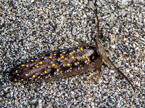| Home |
| Acknowledgments |
| Conventions |
| Glossary |
| Maps |
| References |
| Links |
| Articles |
| Thumbnails |
| Species
list |
| Family |
| Next
species |
Additional Photos

detail

top

side

front

orange foot corner

fewer spots

young

Cerberilla albopunctata Baba, 1976

| Maximum size: ( ) Identification: This is a dusky-cream animal with long cephalic tentacles and a broad foot. The cerata are stained with brown and have moderately narrow, yellow medial bands. The head has darker brown bands and there's a patch of yellow between the cephalic tentacles. There are prominent yellow bars in front of the rhinophores. The rhinophores become darker with age and the notum becomes extensively mottled. The cephalic tentacles and sides are decorated with well-defined white spots. Some posterior cerata in mature animals have brown tips while the ventral cerata may lack yellow bands (particularly in the anterior clusters). In contrast to Cerberilla sp. #1, the central notum is largely exposed, anteriorly. Natural history: Cerberilla albopunctata is a rare species found on open sand and in Halimeda kanaloana beds at 4-24 m (12-78 ft). It's been observed crawling in the open by day. (Note 1) A young animal was observed feeding on an anemone while in a holding dish. (Note 2). Distribution: Big Island and Maui: widely distributed in the Western Pacific. Taxonomic notes: It was first recorded in Hawaii from Wahikuli Park, Maui by CP on July 15, 1996. Photo: Ralph Turre: Maalaea Bay, Maui; June 21, 2014. Observations and comments: Note 1: Rebecca Bicker photographed her animal, by day, at Maalaea Bay in association with numerous, diurnally active Cerberilla sp. #1. Ralph Turre's photo was probably also taken during the day. Note 2: When a 7 mm animal was offered a 3 mm anemone attached to the side of a dish, it began feeding on it immediately after contact with its cephalic tentacles. When feeding, it extended its buccal tube and rasped the column of the anemone while folding its cephalic tentacles along the sides of its body. It rasped for several "bites" then crawled over the anemone, turned and repeated the sequence. Several such "attack sequences" were completed before the anemone was fully consumed. The use of a repeated, stereotyped "attack sequence" rather than continuous feeding suggests that it may normally feed on sand dwelling species that can withdraw or otherwise escape after one or two bites. |
| Thumbnails |
Species
list |
Family | Next species | Top |